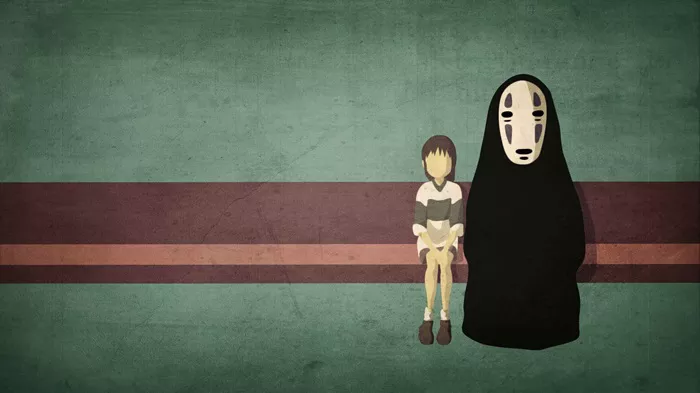In the realm of animated films, few have reached the poetic depth and narrative complexity seen in Hayao Miyazaki’s “Spirited Away.” Released in 2001 by Studio Ghibli, this film not only won the Academy Award for Best Animated Feature but also captured the hearts and imaginations of audiences worldwide. A pivotal character in this enchanted narrative is No-Face, a mysterious and initially unsettling spirit whose interactions with the protagonist, Chihiro, underscore some of the film’s central themes. This article delves deep into the reasons behind No-Face’s assistance to Chihiro, exploring the intricacies of his character and the symbolic meanings embedded in his actions.
Understanding “Spirited Away” and Its Enigmatic Cast
“Spirited Away” tells the story of Chihiro Ogino, a sullen ten-year-old girl who, while moving to a new neighborhood, stumbles into a world ruled by gods, witches, and spirits. Among the film’s rich tapestry of characters, No-Face stands out due to his unique appearance and enigmatic nature. To fully understand why No-Face helps Chihiro, it is crucial to first comprehend the setting of the story and the relationships that define its progress.
The Spirit World: A Reflection of Human Desires and Fears
The world Chihiro enters is a bustling bathhouse for the gods, a place where spirits come to rejuvenate themselves. This environment is not just a physical realm but a psychological landscape that mirrors the complexities of human emotions, desires, and fears. It is within this context that No-Face’s actions and motivations can be interpreted.
Character Analysis: No-Face, the Lonely Spirit
No-Face is introduced as a shadowy, voiceless spirit wearing a mask that conceals any expression. His ability to absorb and mirror the characteristics and desires of those around him makes him a complex figure in the narrative. Initially, No-Face appears benign, but as he ingests more of the bathhouse’s greedy, consumption-driven environment, he becomes a monstrous creature, embodying the negative traits he has absorbed.
The Meeting of Two Souls: No-Face and Chihiro
Chihiro, unlike other characters, shows kindness to No-Face, offering him food and acknowledging his presence when others either ignore or fear him. This initial act of kindness becomes a pivotal moment in their relationship. Chihiro’s compassion stands in stark contrast to the greed exemplified by other characters in the bathhouse, particularly Yubaba, the greedy witch who runs the establishment.
Why Does No-Face Help Chihiro? Unpacking the Layers of Assistance
Mutual Recognition of Loneliness and Innocence: One of the primary reasons No-Face helps Chihiro is their shared sense of isolation. Chihiro, removed from her parents and lost in a strange world, and No-Face, an enigmatic being without a place in the spirit world, find solace in each other’s company. No-Face perceives Chihiro’s innocence and purity, which contrasts sharply with the corrupt nature of the bathhouse, making him gravitate towards her as a beacon of hope.
Chihiro’s Influence: A Catalyst for Change: Chihiro’s influence on No-Face is profound. Her simple acts of kindness not only provide him with companionship but also begin to cleanse him of the corruption he has absorbed. By helping Chihiro, No-Face is, in many ways, seeking redemption and a return to his less corrupted state. This mutual benefit marks their relationship as one of the core emotional exchanges in the film.
A Journey Towards Self-Discovery: As Chihiro navigates the challenges of the spirit world, she matures and discovers her own inner strength and resilience. No-Face’s assistance is crucial in this journey. By helping her, he facilitates her growth and self-realization, which in turn allows him to find a new purpose beyond his initial existential wandering.
The Symbolism of No-Face’s Assistance: No-Face’s help is not merely literal but deeply symbolic. In Miyazaki’s films, spiritual and character transformations are often interconnected. No-Face’s transformation from a consuming monster back to a harmless spirit parallels Chihiro’s transformation from a scared, helpless child to a confident, capable individual. Their transformations are symbiotic, each aiding the other in crucial ways.
Conclusion: The Enduring Legacy of No-Face and Chihiro’s Relationship
In “Spirited Away,” every character, setting, and action carries layers of meaning, and No-Face is no exception. His assistance to Chihiro is a narrative device that serves multiple functions – it propels the story forward, highlights themes of consumption versus compassion, and facilitates the emotional and psychological growth of the characters. Through his relationship with Chihiro, No-Face is transformed from a feared and misunderstood entity into a sympathetic figure, embodying the possibilities of redemption and change.
No-Face’s role in helping Chihiro is a testament to Miyazaki’s ability to weave complex characters into enchanting narratives, making “Spirited Away” not just a film for children but a profound exploration of human emotions and societal reflections. As audiences continue to revisit and analyze this masterpiece, the layers of meaning in No-Face’s actions and his relationship with Chihiro will undoubtedly continue to inspire and provoke thought, cementing the film’s place as a landmark in cinematic history.

